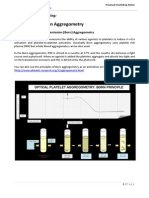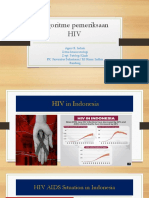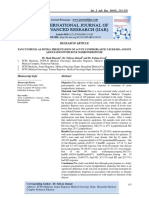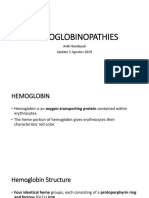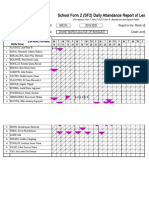AFP
AFP
Uploaded by
Hassan GillCopyright:
Available Formats
AFP
AFP
Uploaded by
Hassan GillCopyright
Available Formats
Share this document
Did you find this document useful?
Is this content inappropriate?
Copyright:
Available Formats
AFP
AFP
Uploaded by
Hassan GillCopyright:
Available Formats
04481798190V10
AFP
AFP α1-fetoprotein
REF 04481798 190 100 tests • 2nd incubation: After addition of streptavidin-coated microparticles,
the complex becomes bound to the solid phase via interaction
• Indicates analyzers on which the kit can be used
of biotin and streptavidin.
MODULAR • The reaction mixture is aspirated into the measuring cell where the
Elecsys 2010 cobas e 411 cobas e 601 microparticles are magnetically captured onto the surface of the
ANALYTICS E170
electrode. Unbound substances are then removed with ProCell/ProCell M.
• • • • Application of a voltage to the electrode then induces chemiluminescent
emission which is measured by a photomultiplier.
• Results are determined via a calibration curve which is
English
instrument-specifically generated by 2-point calibration and a
Please note master curve provided via the reagent barcode.
The measured AFP value of a patient’s sample can vary depending on the a) Tris(2,2’-bipyridyl)ruthenium(II)-complex (Ru(bpy)2+
3 )
testing procedure used. The laboratory finding must therefore always contain a
statement on the AFP assay method used. AFP values determined on patient Reagents - working solutions
samples by different testing procedures cannot be directly compared with one M Streptavidin-coated microparticles (transparent cap), 1 bottle, 6.5 mL:
another and could be the cause of erroneous medical interpretations. Streptavidin-coated microparticles 0.72 mg/mL; preservative.
If there is a change in the AFP assay procedure used while monitoring therapy, R1 Anti-AFP-Ab~biotin (gray cap), 1 bottle, 10 mL:
then the AFP values obtained upon changing over to the new procedure Biotinylated monoclonal anti-AFP antibodies (mouse) 4.5 mg/L;
must be confirmed by parallel measurements with both methods. phosphate buffer 100 mmol/L, pH 6.0; preservative.
R2 Anti-AFP-Ab~Ru(bpy)2+ 3 (black cap), 1 bottle, 10 mL:
Intended use Monoclonal anti-AFP antibodies (mouse) labeled with
Immunoassay for the in vitro quantitative determination of α1-fetoprotein ruthenium complex 12.0 mg/L; phosphate buffer 100 mmol/L,
in human serum and plasma. pH 6.0; preservative.
The Elecsys AFP test is intended for the use as:
• An aid in the management of patients with non-seminomatous Precautions and warnings
germ cell tumors. For in vitro diagnostic use.
• As one component in combination with other parameters to evaluate Exercise the normal precautions required for handling all laboratory reagents.
the risk of trisomy 21 (Down syndrome). Further testing is required Disposal of all waste material should be in accordance with local guidelines.
for diagnosis of chromosomal aberrations. Safety data sheet available for professional user on request.
The electrochemiluminescence immunoassay “ECLIA” is intended for Avoid foam formation in all reagents and sample types (specimens,
use on Elecsys and cobas e immunoassay analyzers. calibrators, and controls).
Summary Reagent handling
Alpha1-fetoprotein, an albumin-like glycoprotein with a molecular The reagents in the kit have been assembled into a ready-for-use
weight of 70000 daltons, is formed in the yolk sac, non-differentiated unit that cannot be separated.
liver cells, and the fetal gastro-intestinal tract.1,2 All information required for correct operation is read in from
70-95 % of patients with primary hepatocellular carcinoma the respective reagent barcodes.
have elevated AFP values.3 Storage and stability
The later the stage of non-seminomatous germ cell tumors, the higher Store at 2-8 °C.
the AFP values. Human chorionic gonadotropin (hCG) and AFP are Store the Elecsys AFP reagent kit upright in order to ensure complete
important parameters for estimating the survival rate of patients with availability of the microparticles during automatic mixing prior to use.
advanced, non-seminomatous germ cell tumors.4,5,6 Stability:
No correlation between the AFP concentration and tumor size, tumor
growth, stage or degree of malignancy has so far been demonstrated. unopened at 2-8 °C up to the stated expiration date
Greatly elevated AFP values generally indicate primary liver cell carcinoma. after opening at 2-8 °C 12 weeks
When liver metastasis exists, the AFP values are generally below on the analyzers 8 weeks
350-400 IU/mL. As the AFP values rise during regeneration of the liver,
moderately elevated values are found in alcohol-mediated liver cirrhosis Specimen collection and preparation
and acute viral hepatitis as well as in carriers of HBsAg.7 Only the specimens listed below were tested and found acceptable.
The determination of AFP to screen the general population for Serum collected using standard sampling tubes or tubes
cancer is, however, not to be recommended. containing separating gel.
Elevated AFP concentrations in maternal serum or amniotic fluid Li-heparin, sodium heparin, K3-EDTA, and sodium citrate plasma. When
during pregnancy can indicate spina bifida, anencephalia, atresia of sodium citrate is used, the results must be corrected by + 10 %.
the oesophagus or multiple pregnancy.8,9,10,11 Criterion: Recovery within 90-110 % of serum value or slope 0.9-1.1 + intercept
Measurement of AFP makes a contribution to the risk assessment for within < ± 2 x analytical sensitivity (LDL) + coefficient of correlation > 0.95.
trisomy 21 (Down syndrome) in the second trimester of pregnancy together Stable for 7 days at 2-8 °C, 3 months at -20 °C.19
with hCG+β and other parameters, such as exact gestational age and maternal The suitability of plasma samples for estimating the risk of
weight. In a trisomy 21 affected pregnancy the maternal serum concentration trisomy 21 has not been evaluated.
of AFP is decreased whereas the maternal serum hCG+β concentration is The sample types listed were tested with a selection of sample collection tubes
approximately twice the normal median.12 The risk for a trisomy 21 affected that were commercially available at the time of testing, i.e. not all available
pregnancy in the second trimester can be calculated by a suitable software (see tubes of all manufacturers were tested. Sample collection systems from
“Materials required, but not provided” section) using the algorithm as described various manufacturers may contain differing materials which could affect
by Wald13 and the respective assay-specific parameters.12,13,14,15,16,17,18 the test results in some cases. When processing samples in primary tubes
(sample collection systems), follow the instructions of the tube manufacturer.
Test principle Centrifuge samples containing precipitates before performing the
Sandwich principle. Total duration of assay: 18 minutes. assay. Do not use heat-inactivated samples. Do not use samples
• 1st incubation: 10 µL of sample, a biotinylated monoclonal AFP-specific and controls stabilized with azide.
antibody, and a monoclonal AFP-specific antibody labeled with a Ensure the samples, calibrators, and controls are at ambient
ruthenium complexa react to form a sandwich complex. temperature (20-25 °C) before measurement.
2011-09, V 10 English 1/4 Elecsys and cobas e analyzers
AFP
AFP α1-fetoprotein
Due to possible evaporation effects, samples, calibrators, and controls on Quality control
the analyzers should be analyzed/measured within 2 hours. For quality control, use Elecsys PreciControl Tumor Marker or
Elecsys PreciControl Universal.
Materials provided Other suitable control material can be used in addition.
See “Reagents - working solutions” section for reagents. Controls for the various concentration ranges should be run individually
Materials required (but not provided) at least once every 24 hours when the test is in use, once per reagent
• REF 04487761190, AFP CalSet II, for 4 x 1 mL kit, and following each calibration. The control intervals and limits
should be adapted to each laboratory’s individual requirements. Values
• REF 11776452122, PreciControl Tumor Marker, for 2 x 3 mL each of
obtained should fall within the defined limits.
PreciControl Tumor Marker 1 and 2 or
REF 11731416190, PreciControl Universal, for 2 x 3 mL each
Each laboratory should establish corrective measures to be taken
if values fall outside the defined limits.
of PreciControl Universal 1 and 2
Follow the applicable government regulations and local guidelines
• REF 11732277122, Diluent Universal, 2 x 16 mL sample diluent or
for quality control.
REF 03183971122, Diluent Universal, 2 x 36 mL sample diluent
• General laboratory equipment Calculation
• Elecsys 2010, MODULAR ANALYTICS E170 or cobas e analyzer The analyzer automatically calculates the analyte concentration of
For risk calculation of trisomy 21: each sample either in IU/mL, ng/mL, kIU/L or additionally in IU/L with
MODULAR ANALYTICS E170 and cobas e 601 analyzers.
• A suitable software, e.g.
REF 05126193, SsdwLab (V5.0 or later), single user licence Conversion factors: IU/mL x 1.21 = ng/mL
REF 05195047, SsdwLab (V5.0 or later), multi user licence ng/mL x 0.83 = IU/mL
• REF 03271749190, HCG+β, 100 tests Limitations - interference
• REF 03302652190, HCG+β CalSet, for 4 x 1 mL The assay is unaffected by icterus (bilirubin < 1112 µmol/L or < 65 mg/dL),
Accessories for Elecsys 2010 and cobas e 411 analyzers: hemolysis (Hb < 1.4 mmol/L or < 2.2 g/dL), lipemia (Intralipid < 1500 mg/dL),
• REF 11662988122, ProCell, 6 x 380 mL system buffer and biotin < 246 nmol/L or < 60 ng/mL.
• REF 11662970122, CleanCell, 6 x 380 mL measuring cell cleaning solution Criterion: Recovery within ± 10 % of initial value.
Samples should not be taken from patients receiving therapy
• REF 11930346122, Elecsys SysWash, 1 x 500 mL washwater additive
with high biotin doses (i.e. > 5 mg/day) until at least 8 hours
• REF 11933159001, Adapter for SysClean following the last biotin administration.
• REF 11706802001, Elecsys 2010 AssayCup, 60 x 60 reaction vessels No interference was observed from rheumatoid factors up to
• REF 11706799001, Elecsys 2010 AssayTip, 30 x 120 pipette tips a concentration of 1500 IU/mL.
Accessories for MODULAR ANALYTICS E170 and cobas e 601 analyzers: There is no high-dose hook effect at AFP concentrations up to
• REF 04880340190, ProCell M, 2 x 2 L system buffer 1 million IU/mL (1.21 million ng/mL).
• REF 04880293190, CleanCell M, 2 x 2 L measuring cell cleaning solution In vitro tests were performed on 26 commonly used pharmaceuticals.
No interference with the assay was found.
• REF 03023141001, PC/CC-Cups, 12 cups to prewarm ProCell M
In rare cases, interference due to extremely high titers of antibodies to
and CleanCell M before use
analyte-specific antibodies, streptavidin or ruthenium can occur. These
• REF 03005712190, ProbeWash M, 12 x 70 mL cleaning solution for effects are minimized by suitable test design.
run finalization and rinsing during reagent change For diagnostic purposes, the results should always be assessed in conjunction
• REF 12102137001, AssayTip/AssayCup Combimagazine M, 48 magazines with the patient’s medical history, clinical examination and other findings.
x 84 reaction vessels or pipette tips, waste bags
• REF 03023150001, WasteLiner, waste bags Limits and ranges
Measuring range
• REF 03027651001, SysClean Adapter M
0.500-1000 IU/mL or 0.605-1210 ng/mL (defined by the lower detection
Accessories for all analyzers: limit and the maximum of the master curve). Values below the detection
• REF 11298500316, Elecsys SysClean, 5 x 100 mL system cleaning solution limit are reported as < 0.500 IU/mL or < 0.605 ng/mL. Values above the
Assay measuring range are reported as > 1000 IU/mL or > 1210 ng/mL (or up to
For optimum performance of the assay follow the directions given in 50000 IU/mL or 60500 ng/mL for 50-fold diluted samples).
this document for the analyzer concerned. Refer to the appropriate Lower limits of measurement
operator’s manual for analyzer-specific assay instructions. Lower detection limit of the test
Resuspension of the microparticles takes place automatically prior to use. Lower detection limit: 0.50 IU/mL (0.61 ng/mL)
Read in the test-specific parameters via the reagent barcode. If in exceptional The lower detection limit represents the lowest measurable analyte
cases the barcode cannot be read, enter the 15-digit sequence of numbers. level that can be distinguished from 0. It is calculated as the value
Bring the cooled reagents to approx. 20 °C and place on the reagent disk (20 °C) lying 2 standard deviations above that of the lowest standard (master
of the analyzer. Avoid foam formation. The system automatically regulates calibrator, standard 1 + 2 SD, repeatability study, n = 21).
the temperature of the reagents and the opening/closing of the bottles. Dilution
Calibration Samples with AFP concentrations above the measuring range can be diluted
Traceability: This method has been standardized against the 1st with Elecsys Diluent Universal. The recommended dilution is 1:50 (either
IRP WHO Reference Standard 72/225. automatically by the MODULAR ANALYTICS E170, Elecsys 2010 and cobas e
Every Elecsys AFP reagent set has a barcoded label containing the specific analyzers or manually). The concentration of the diluted sample must be
information for calibration of the particular reagent lot. The predefined master > 20 IU/mL (24 ng/mL). After manual dilution, multiply the result by the
curve is adapted to the analyzer using the Elecsys AFP CalSet II. dilution factor. After dilution by the analyzers, the MODULAR ANALYTICS
Calibration frequency: Calibration must be performed once per E170, Elecsys 2010 and cobas e software automatically takes the dilution
reagent lot using fresh reagent (i.e. not more than 24 hours since the into account when calculating the sample concentration.
reagent kit was registered on the analyzer).
Renewed calibration is recommended as follows:
• after 1 month (28 days) when using the same reagent lot
• after 7 days (when using the same reagent kit on the analyzer)
• as required: e.g. quality control findings outside the defined limits
Elecsys and cobas e analyzers 2/4 2011-09, V 10 English
04481798190V10
AFP
AFP α1-fetoprotein
Expected values MODULAR ANALYTICS E170 and cobas e 601 analyzers
Results of following studies using the Elecsys AFP assay see below: Repeatability Intermediate precision
a) Multicenter study “Elecsys 2010 analyzer” status September Sample Mean SD CV Mean SD CV
1997 and reference range study in Germany and France, data IU/mL ng/mL IU/mL ng/mL % IU/mL ng/mL IU/mL ng/mL %
evaluated in September 1998. HS 1 14.8 17.8 0.27 0.33 1.8 14.1 17.0 0.53 0.64 3.8
Following AFP values were found in serum samples from HS 2 46.7 56.5 0.65 0.79 1.4 44.6 53.9 1.14 1.38 2.6
646 healthy test subjects: HS 3 745 901 11.7 14.2 1.6 711 860 23.4 28.3 3.3
≤ 5.8 IU/mL or ≤ 7.0 ng/mL for 95 % of the results.
PC TM1 9.35 11.3 0.21 0.25 2.2 9.1 11.0 0.26 0.31 2.8
AFP median values for completed weeks of pregnancy (defined as completed
weeks of pregnancy beginning with the start of the last menstruation phase): PC TM2 104 126 2.49 3.01 2.4 103 125 2.54 3.07 2.5
Weeks 14 15 16 17 18 19 Method comparison
N 382 1782 2386 975 353 146 A comparison of the Elecsys AFP assay (y) with the Enzymun-Test AFP
IU/mL 23.2 25.6 30.0 33.5 40.1 45.5 method (x) using clinical samples gave the following correlations (IU/mL):
ng/mL 27.9 30.9 36.1 40.4 48.3 54.8 Number of samples measured: 77
b) Multicenter study to determine reference values for evaluating the risk of Passing/Bablok20 Linear regression
trisomy 21 in maternal serum (study No. BO1P019, status March 2003). y = 0.92x - 1.51 y = 0.90x + 0.35
Values from serum samples of 1753 pregnant women in total (relevant τ = 0.975 r = 0.998
gestational weeks 14 to 18) were evaluated. The sample concentrations were between approx. 2 and
Measurements with the Elecsys HCG+β assay and the Elecsys AFP assay 500 IU/mL (2.4 and 600 ng/mL).
were conducted in 5 clinical centers in Belgium, France, and Germany.
The gestational age in days determined by ultrasound was given for each References
sample. From a log-linear regression analysis of all 1753 AFP values 1. Taketa K. Alpha-Fetoprotein in the 1990s. In: Sell SS. Serological cancer
versus gestational age the following median values were calculated for markers. Humana Press 1992;31-46, ISBN: 0-89603-209-4.
the middle of the respective weeks (e.g. week 14 + 3 days): 2. Ruoslathi E, Engvall E, Kessler MJ. Chemical Properties
Weeks 14 15 16 17 18 of Alpha-Fetoprotein. In: Herberman RB, McIntire KR (eds).
IU/mL 20.9 24.0 27.6 31.7 36.4 Immunodiagnosis of Cancer. New York: Marcel Dekker Inc 1979:101-117.
ng/mL 25.3 29.0 33.3 38.3 44.0 3. Ramsey WH, Wu GY. Hepatocellular carcinoma: update on diagnosis
and treatment. Dig-Dis 1995;13,2:81-91.
Note: For prenatal testing it is recommended that the median values be 4. Sato Y, Nakata K, Kato Y, et al. Early recognition of hepatocellular
re-evaluated periodically (1 to 3 years) and whenever methodology changes. carcinoma based on altered profiles of alpha-fetoprotein. New
The transferability of the reference values to plasma samples Engl J Med 1993;328,25:1802-1806.
has not been verified. 5. Klepp O. Serum tumor markers in testicular and extragonadal germ cell
Each laboratory should investigate the transferability of the expected values to malignancies. Scand J Clin Lab Invest Suppl 1991;206:28-41.
its own patient population and if necessary determine its own reference ranges. 6. Sturgeon C. Practice Guidelines for Tumor Marker Use in the
Clinic. Clin Chem 2002;48(8):1151-1159.
Specific performance data 7. Stuart KE, Anand AJ, Jenkins RL. Hepatocellular Carcinoma in
Representative performance data on the analyzers are given below. the United States. Cancer 1996;77,11:2217-2222.
Results obtained in individual laboratories may differ. 8. Brewer JA, Tank ES. Yolk sac tumors and alpha-fetoprotein in
first year of life. Urology 1993;42,1:79-80.
Precision
9. Wald NJ, Kennard A, Densem JW, et al. Antenatal maternal
Precision was determined using Elecsys reagents, pooled human
serum screening for Down’s syndrome: results of a demonstration
sera, and controls in accordance with a modified protocol (EP5-A) of
project. BMJ 1992;305:391-394.
the CLSI (Clinical and Laboratory Standards Institute): 6 times daily
10. Canick JA, Saller DN Jr. Maternal serum screening for aneuploidy and
for 10 days (n = 60); repeatability on MODULAR ANALYTICS E170
open fetal defects. Obstet Gynecol Clin North Am 1993;20,3:443-454.
analyzer, n = 21. The following results were obtained:
11. Bendon RW. The anatomic basis of maternal serum screening.
Elecsys 2010 and cobas e 411 analyzers Ann Clin Lab Sci 1991;(21)1:36-39.
Repeatabilityb Intermediate precision 12. Schlebusch H. Prenatal screening for Down’s syndrome. In: Thomas L
Sample Median SD CV SD CV (ed.). Clinical Laboratory Diagnosis, TH-Books, Frankfurt, 1st English
IU/mL ng/mL IU/mL ng/mL % IU/mL ng/mL % edition 1998:1124-1125, deutsche Auflage 1998:1149-1150.
13. Cuckle HS, Wald NJ, Thompson SG. Estimating a woman’s risk of having
HSc 1 12.8 15.5 0.26 0.31 2.0 0.39 0.47 3.1
a pregnancy associated with Down’s syndrome using her age and serum
HS 2 42.6 51.5 0.63 0.76 1.5 1.02 1.24 2.4 alpha-fetoprotein level. Br J Obstet Gynaecol 1987;94:387-402.
HS 3 566 685 11.2 13.5 2.0 15.6 18.9 2.8 14. Reynolds TM, Penney MD. The mathematical basis of multivariate risk
PC TMd1 8.01 9.69 0.22 0.27 2.8 0.28 0.33 3.4 screening: with special reference to screening for Down’s syndrome
PC TM2 86.8 105 1.92 2.33 2.2 2.33 2.82 2.7 associated pregnancy. Ann Clin Biochem 1989;26:452-458.
b) Repeatability = within-run precision 15. Cuckle HS, Wald NJ, Nanchahal K, et al. Repeat maternal serum
c) HS = human serum alpha-fetoprotein testing in antenatal screening programmes for Down’s
d) PC TM = PreciControl Tumor Marker
syndrome. Br J Obstet Gynaecol 1989;96:52-60.
16. Dunstan FDJ, Gray JC, Nix ABJ, et al. Detection rates and false
positive rates for Down’s Syndrome screening: How precisely
can they be Estimated and what factors influence their value?
Statistics Medicine 1997;16:1481-1495.
17. Lamson SH, Hook B. Comparison of Mathematical Models for
the Maternal Age Dependence of Down’s Syndrome Rates.
Hum Genet Vol 1981;59:232-234.
18. Cuckle HS. Improved parameters for risk estimation in Down’s
syndrome screening. Prenat Diagn 1995;15:1057-1065.
2011-09, V 10 English 3/4 Elecsys and cobas e analyzers
AFP
AFP α1-fetoprotein
19. Guder WG, Narayanan S, Wisser H, et al. List of Analytes; Preanalytical
Variables. Brochure in: Samples: From the Patient to the Laboratory.
GIT-Verlag, Darmstadt 1996:10. ISBN 3-928865-22-6.
20. Passing H, Bablok W, Bender R, et al. A general regression
procedure for method transformation. J Clin Chem Clin
Biochem 1988 Nov;26(11):783-790.
For further information, please refer to the appropriate operator’s manual
for the analyzer concerned, the respective application sheets, the product
information, and Method Sheets of all necessary components.
COBAS, COBAS E, ELECSYS, ENZYMUN-TEST and MODULAR are trademarks of Roche. INTRALIPID is a
trademark of Fresenius Kabi AB. Other brand or product names are trademarks of their respective holders.
Significant additions or changes are indicated by a change bar in the margin. Changes to reagent barcode
test parameters which have already been read in should be edited manually.
© 2011, Roche Diagnostics
0123
Roche Diagnostics GmbH, Sandhofer Strasse 116, D-68305 Mannheim
www.roche.com
Elecsys and cobas e analyzers 4/4 2011-09, V 10 English
You might also like
- Avance - CS2 - (MANUAL DE SERVICIO)Document486 pagesAvance - CS2 - (MANUAL DE SERVICIO)Ignacio Nicolas100% (15)
- Bendi AC PM F-523-R4 PDFDocument128 pagesBendi AC PM F-523-R4 PDFMonserrat Hernández SánchezNo ratings yet
- Glycolysis - LippincottsDocument11 pagesGlycolysis - LippincottsJulia QuimadaNo ratings yet
- Hormon Paratiroid: Dr. Muniroh, SP - PKDocument10 pagesHormon Paratiroid: Dr. Muniroh, SP - PKFuadi FaisalNo ratings yet
- Roles of Husband and WifeDocument33 pagesRoles of Husband and Wifejenny ramosNo ratings yet
- Internal Control Weaknesses RecommendationsDocument2 pagesInternal Control Weaknesses RecommendationsexquisiteNo ratings yet
- 1.prof Suzanna ImmanuelDocument54 pages1.prof Suzanna Immanuelbudi darmantaNo ratings yet
- Hema Part 3 Final PDFDocument188 pagesHema Part 3 Final PDFH.B.ANo ratings yet
- EritrositDocument12 pagesEritrositNatasya HerinNo ratings yet
- Webinar INAEQAS 27062020. Adhi K. Sugianli, DR., SPPK (K), M.Kes. How To Read The Gram Panel-1Document20 pagesWebinar INAEQAS 27062020. Adhi K. Sugianli, DR., SPPK (K), M.Kes. How To Read The Gram Panel-1Rini WidyantariNo ratings yet
- HepatitisDocument46 pagesHepatitisGusti Tirtha Drag JrNo ratings yet
- Haematology: Questions&AnswersDocument87 pagesHaematology: Questions&AnswersCielNo ratings yet
- Clinical Pathology Med School, Padjadjaran UniversityDocument38 pagesClinical Pathology Med School, Padjadjaran UniversityJenadi BinartoNo ratings yet
- Unit 1: Scope of Clinical ChemistryDocument79 pagesUnit 1: Scope of Clinical ChemistryMegumi TadokoroNo ratings yet
- PPT MA - RevisiDocument76 pagesPPT MA - RevisiullifannuriNo ratings yet
- Immature GranulocytesDocument10 pagesImmature Granulocytespieterinpretoria391No ratings yet
- GenePath DX BCR ABL - IFUDocument4 pagesGenePath DX BCR ABL - IFUnbiolab6659No ratings yet
- 24 Feb Glycated Markers in DMDocument77 pages24 Feb Glycated Markers in DMNurul FahmizaNo ratings yet
- Gastroenterohepatology 2Document36 pagesGastroenterohepatology 2Laboratorium Ansari SalehNo ratings yet
- Tumor Markeri - Eng PDFDocument79 pagesTumor Markeri - Eng PDFdr_4uNo ratings yet
- Hemostasis Dan Koagulasi: DR - Fedelia Raya, M.Kes, SPPK Bagian Patologi Klinik Fk-UhoDocument18 pagesHemostasis Dan Koagulasi: DR - Fedelia Raya, M.Kes, SPPK Bagian Patologi Klinik Fk-UhoToraoNo ratings yet
- Acute-On-Chronic Liver Failure - Controversies and ConsensusDocument10 pagesAcute-On-Chronic Liver Failure - Controversies and ConsensusPhan Nguyễn Đại NghĩaNo ratings yet
- Additional Notes - Light Transmission Aggregometry NotesDocument7 pagesAdditional Notes - Light Transmission Aggregometry NotesAndrej TerzicNo ratings yet
- 3 MicrobialNutritionGrowthDocument100 pages3 MicrobialNutritionGrowthHanzel GarcitosNo ratings yet
- Algoritma Tes HIVDocument31 pagesAlgoritma Tes HIVyurdiansyahNo ratings yet
- Pancytopenia As Initial Presentation of Acute Lymphoblastic Leukemia and Its Associationwith Bone MarrowresponseDocument6 pagesPancytopenia As Initial Presentation of Acute Lymphoblastic Leukemia and Its Associationwith Bone MarrowresponseIJAR JOURNALNo ratings yet
- Mean Platelet Volume To Lymphocyte Ratio As A Novel Marker For Diabetic NephropathyDocument4 pagesMean Platelet Volume To Lymphocyte Ratio As A Novel Marker For Diabetic NephropathyNurlinaNo ratings yet
- BCR - Abl Oncogene: Pramod DarvinDocument16 pagesBCR - Abl Oncogene: Pramod DarvinPramod DarvinNo ratings yet
- Para Protein Emi ADocument14 pagesPara Protein Emi AMohamoud MohamedNo ratings yet
- New Red Blood Cell and Reticulocyte Parameters and Reference Values For Healthy Individuals and in Chronic Kidney Disease.Document8 pagesNew Red Blood Cell and Reticulocyte Parameters and Reference Values For Healthy Individuals and in Chronic Kidney Disease.Alberto MarcosNo ratings yet
- 3-1 HbA1c Clase 1Document26 pages3-1 HbA1c Clase 1Marcelo RemacheNo ratings yet
- Bismillah..a.yuli FlowcytometriDocument40 pagesBismillah..a.yuli FlowcytometriYuli RohmaNo ratings yet
- Hemoglobin Opa ThiesDocument34 pagesHemoglobin Opa ThiesFebri fitraNo ratings yet
- Acinetobacter Baumannii by Gemechis DejeneDocument36 pagesAcinetobacter Baumannii by Gemechis DejeneGemechis DejeneNo ratings yet
- Pendukung Mikroalbuminuria, Kreatini, UcrDocument21 pagesPendukung Mikroalbuminuria, Kreatini, UcrHesty AshanNo ratings yet
- Platelets: Veena ShriramDocument58 pagesPlatelets: Veena ShriramVeena ShriramNo ratings yet
- Thyroid HormonesDocument63 pagesThyroid HormonesDr. M. Prasad NaiduNo ratings yet
- Forward and Reverse TypingDocument10 pagesForward and Reverse TypingDanica AgojoNo ratings yet
- AST by The CDS Methode PDFDocument88 pagesAST by The CDS Methode PDFari_nuswantoroNo ratings yet
- Monolisa HCV Ag-Ac UltraDocument4 pagesMonolisa HCV Ag-Ac UltraSantiagoAFNo ratings yet
- Hema Ii Laboratory Week 6Document65 pagesHema Ii Laboratory Week 6Al-hadad AndromacheNo ratings yet
- Natriuretic Peptide SystemDocument30 pagesNatriuretic Peptide SystemKhaled S. Harb100% (1)
- Bioline Rapid. Urinalysis Test PDFDocument34 pagesBioline Rapid. Urinalysis Test PDFGail IbanezNo ratings yet
- L04 Plasma Protein PDFDocument63 pagesL04 Plasma Protein PDFNatashaCameliaNo ratings yet
- Bacteriology Lecture (Finals)Document153 pagesBacteriology Lecture (Finals)Faith Ann CortezNo ratings yet
- TechTalk - August2010 Clump in EDTA Tubes PDFDocument2 pagesTechTalk - August2010 Clump in EDTA Tubes PDFARIF AHAMMED PNo ratings yet
- MMDocument67 pagesMMRatnaNo ratings yet
- List of NGSP Certified MethodsDocument17 pagesList of NGSP Certified MethodsTisha Patricia OedoyNo ratings yet
- K6 - Kelainan - HemostasisDocument60 pagesK6 - Kelainan - HemostasisAis ChaaNo ratings yet
- Laboratory Hemostatic DisordersDocument41 pagesLaboratory Hemostatic DisordersYohanna SinuhajiNo ratings yet
- Dr. Basti Andriyoko, SP - PK (K) - Penanganan Spesimen Swab Untuk Pemeriksaan PCR SARS-CoV-2. PDSPatKLIn 18072020 PDFDocument24 pagesDr. Basti Andriyoko, SP - PK (K) - Penanganan Spesimen Swab Untuk Pemeriksaan PCR SARS-CoV-2. PDSPatKLIn 18072020 PDFRini WidyantariNo ratings yet
- Burkholderia PseudomalleiDocument2 pagesBurkholderia Pseudomalleimicrobehunter007No ratings yet
- Prof Mansyur - General Lecture - Current Challenges in Hemostatic LaboratoryDocument28 pagesProf Mansyur - General Lecture - Current Challenges in Hemostatic LaboratoryRini WidyantariNo ratings yet
- Anemia Def B12 Dan As FolatDocument30 pagesAnemia Def B12 Dan As Folatinas khoirunnisaNo ratings yet
- BCCA Febrile Neutropenia GuidelinesDocument2 pagesBCCA Febrile Neutropenia GuidelinesdenokayuMRNo ratings yet
- UX-2000 Features & KeypointsDocument29 pagesUX-2000 Features & KeypointsLee-Ya AchmadNo ratings yet
- Anemia Penyakit KronikDocument12 pagesAnemia Penyakit KronikFaridhatulNo ratings yet
- Coatron A4: Fully Automated Hemostasis AnalyzerDocument6 pagesCoatron A4: Fully Automated Hemostasis AnalyzerThe KaiTo GamerNo ratings yet
- Platelet ProductionDocument31 pagesPlatelet ProductionRaiza RuizNo ratings yet
- AAK ANA Komplett Kunde PDFDocument64 pagesAAK ANA Komplett Kunde PDFm parasiteNo ratings yet
- RFIT-PRT-0895 FilmArrayPneumoplus Instructions For Use EN PDFDocument112 pagesRFIT-PRT-0895 FilmArrayPneumoplus Instructions For Use EN PDFGuneyden GuneydenNo ratings yet
- AFP 04481801001 - enDocument4 pagesAFP 04481801001 - enArnaz AdisaputraNo ratings yet
- Afp 2018-10 v14Document4 pagesAfp 2018-10 v14Mohammed AliNo ratings yet
- Insert - Elecsys AFP.04481798500.V17.enDocument6 pagesInsert - Elecsys AFP.04481798500.V17.enIfthon Adji PrastyoNo ratings yet
- 05 MicrobiologyDocument90 pages05 MicrobiologyHassan GillNo ratings yet
- MLT Students ADocument272 pagesMLT Students AHassan GillNo ratings yet
- 04 ImmnologyDocument51 pages04 ImmnologyHassan GillNo ratings yet
- 02 ChemistryDocument70 pages02 ChemistryHassan GillNo ratings yet
- 01 Blood BankingDocument74 pages01 Blood BankingHassan GillNo ratings yet
- 06 FlamephotometerDocument10 pages06 FlamephotometerHassan GillNo ratings yet
- 08 Ion Selective Electrodes-pH MeterDocument16 pages08 Ion Selective Electrodes-pH MeterHassan GillNo ratings yet
- 07 Turbidimetry - Nephelometry & LaserDocument12 pages07 Turbidimetry - Nephelometry & LaserHassan GillNo ratings yet
- 05 FluorometerDocument26 pages05 FluorometerHassan GillNo ratings yet
- 02 SpectrophotometerDocument40 pages02 SpectrophotometerHassan GillNo ratings yet
- E Digitoxin en 10Document3 pagesE Digitoxin en 10Hassan GillNo ratings yet
- Past Papers 2014 Faisalabad Board FSC Part 1 Physics ObjectiveDocument1 pagePast Papers 2014 Faisalabad Board FSC Part 1 Physics ObjectiveHassan GillNo ratings yet
- CK MBDocument3 pagesCK MBHassan GillNo ratings yet
- 04 Atomic Absorption SPMDocument15 pages04 Atomic Absorption SPMHassan Gill0% (1)
- E Anti-TSHR Ms en 9Document4 pagesE Anti-TSHR Ms en 9Hassan GillNo ratings yet
- E Anti-TPO en 3Document3 pagesE Anti-TPO en 3Hassan Gill100% (1)
- E CA19-9ms en 20Document3 pagesE CA19-9ms en 20Hassan GillNo ratings yet
- Ca 125 IiDocument4 pagesCa 125 IiHassan GillNo ratings yet
- E Anti-HCVDocument4 pagesE Anti-HCVHassan GillNo ratings yet
- Phrasal VerbsDocument18 pagesPhrasal VerbslinhltkNo ratings yet
- ULSFuel Oil Changeover Procedures Dec 14Document2 pagesULSFuel Oil Changeover Procedures Dec 14Zakariya KareemNo ratings yet
- Chocolate: Mavales, Acute MiasmDocument3 pagesChocolate: Mavales, Acute Miasmnitkol100% (2)
- SUN2000-250KTL-H1 Datasheet - PreliminarDocument1 pageSUN2000-250KTL-H1 Datasheet - PreliminarMaruNo ratings yet
- P4 English Summative Test 1Document12 pagesP4 English Summative Test 1Zhant HidayatullahNo ratings yet
- Sample Email For Travel Request: My Total Estimate For This Travel $XXX - XXDocument1 pageSample Email For Travel Request: My Total Estimate For This Travel $XXX - XXM AsaduzzamanNo ratings yet
- Maintenance Management System Guideline For Maintenance Operating Procedures Master Data ManagementDocument20 pagesMaintenance Management System Guideline For Maintenance Operating Procedures Master Data ManagementGlad BlazNo ratings yet
- Statutory Checklist-Tds OthersDocument15 pagesStatutory Checklist-Tds OthersGaurav KumarNo ratings yet
- 2011 IAGI Makassar Jabung-Block-BasementDocument10 pages2011 IAGI Makassar Jabung-Block-BasementRistiono AgusNo ratings yet
- Assessment: Head and NeckDocument67 pagesAssessment: Head and NeckJojo JustoNo ratings yet
- Hypnosis (1) 30 62 62.odtDocument52 pagesHypnosis (1) 30 62 62.odtVladimir SutanovacNo ratings yet
- Happiful Issue 64Document84 pagesHappiful Issue 64mari mikhnoNo ratings yet
- Module 3Document34 pagesModule 3REGIN VILLASISNo ratings yet
- Paper: Coke Formation in The Oxidative Dehydrogenation of Ethylbenzene To Styrene by TEOMDocument12 pagesPaper: Coke Formation in The Oxidative Dehydrogenation of Ethylbenzene To Styrene by TEOMHanif Angga PutraNo ratings yet
- Assalamoalaikum Warahmatullahe Wabarakatuh: Fee Aman AllahDocument46 pagesAssalamoalaikum Warahmatullahe Wabarakatuh: Fee Aman AllahYasin NayyerNo ratings yet
- Garde 11 Stem A Form 2Document22 pagesGarde 11 Stem A Form 2Maribelle LozanoNo ratings yet
- Assessing Quality of Life in Stuttering TreatmentDocument13 pagesAssessing Quality of Life in Stuttering TreatmentMeagan JonesNo ratings yet
- Your Heart: Build Arms Like ThisDocument157 pagesYour Heart: Build Arms Like ThisNight100% (1)
- Nun S. AmenDocument13 pagesNun S. AmenAnonymous puqCYDnQ100% (1)
- Wounds by Shotguns: by Dilnaaz Baig Roll No-8 Batch 2015 Ii MbbsDocument13 pagesWounds by Shotguns: by Dilnaaz Baig Roll No-8 Batch 2015 Ii Mbbsniraj_sdNo ratings yet
- zzb1271 Micron Filter Brochure Lo Res 29 101 2014 FDocument6 pageszzb1271 Micron Filter Brochure Lo Res 29 101 2014 Fethan8888No ratings yet
- Babysense 5Document2 pagesBabysense 5ozelNo ratings yet
- Fire Pump As PecDocument5 pagesFire Pump As PecLauren OlivosNo ratings yet
- Group 12 RizalDocument53 pagesGroup 12 RizalRoel SampeloNo ratings yet
- Online Smu Natural Science Text BookDocument23 pagesOnline Smu Natural Science Text BookspmajishNo ratings yet
- Classification of ResourcesDocument15 pagesClassification of ResourcesExPSINnerNo ratings yet






















